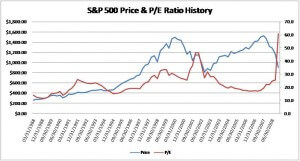Conventional wisdom has long held that the way to become wealthy over the long-term is by compounded investment in the stock market. The reason for this was quite clear when one looked at the chart of historical returns. By making very modest investments at regular intervals over a long period of time, small investors could create very large amounts of wealth. This line of thinking is what has prompted most employers to source their 401k retirement plans with mutual funds that invest in the stock market.
Unfortunately, the movement of stock market investment into the ‘main stream’ of America has caused it to become less of an investment vehicle and more of a gambling casino. The primary purpose of the stock market is to provide companies with a means to raise capital for business investment by selling a partial ownership stake. (Also known as a ‘share’ of ownership) Typically, investors were rewarded for their investment in the by the payment of dividends from the company profits. Thus, stock market investing was originally based on the notion of finding a company that was likely to make sufficient profits to pay healthy dividends.
This sentiment changed as the secondary market for trading stocks became more popular. A ‘primary’ issue of stock happens when a company issues more ownership shares. A ‘secondary’ stock transaction happens when one investor exchanges an existing ownership share with another investor. This is where the stock market turns into a casino. When the focus of investment shifts away from the ability of the company to viably pay dividends on a consistent basis toward the probability that the secondary market will pay more for the company stock at a future date, stock investment becomes much more akin to gambling. When returns are primarily based on price appreciation, continued growth in market value requires a perpetual stream of new buyers. This phenomenon is true for both stocks and real estate, and explains the recent booms/busts very thoroughly.
The only factor that can push-up the entire stock market is if there is an aggregate increase in investment capital. (Similar to how increases in the money supply from the Federal Reserve drive price inflation) When corporate profits grow, it is natural to assume that more capital will be attracted to the market. However, when market values rise faster than corporate profits, the only cause can be a net-influx of investment capital.
In the United States, there were two “Sledge Hammer” events that sparked a colossal 25-year bull market for stocks. The first was the passage of ERISA in 1974, which created standards and stability for company-sponsored stock market investment plans that dramatically increased the supply of equity capital. The second was the pairing of tax cuts in the 1980’s and a significant reduction in the cost of debt capital that spurred a rapid growth in corporate profitability. These two events combined to generate a massive increase in stock market investment that pushed values sky high.
 However, these massive gains came with a bit of a shadow. This problem has been created as investors stopped directly buying stocks of individual companies and started investing in funds where a manager buys and sells the stocks. Now these brokers and managers have control over incredible amounts of other people’s capital. This control gives them the power to create or destroy tremendous amounts of value based on the decisions that they make. It also channels market activity more and more toward ‘gambling’ as managers seek to maximize value appreciation. (This set of incentives is very adverse to investor interests, as managers have incentives to take insane risks, since big gains mean tremendous bonuses and losses only mean that they get fired) Furthermore, most managers charge very hefty fees for their services, which cut into the net investor returns. (Thus far, we have assumed that the fund managers are honest . . . when the ‘crook’ dynamic is factored-in, the risks increase significantly)
However, these massive gains came with a bit of a shadow. This problem has been created as investors stopped directly buying stocks of individual companies and started investing in funds where a manager buys and sells the stocks. Now these brokers and managers have control over incredible amounts of other people’s capital. This control gives them the power to create or destroy tremendous amounts of value based on the decisions that they make. It also channels market activity more and more toward ‘gambling’ as managers seek to maximize value appreciation. (This set of incentives is very adverse to investor interests, as managers have incentives to take insane risks, since big gains mean tremendous bonuses and losses only mean that they get fired) Furthermore, most managers charge very hefty fees for their services, which cut into the net investor returns. (Thus far, we have assumed that the fund managers are honest . . . when the ‘crook’ dynamic is factored-in, the risks increase significantly)
Fundamentally, there are four principal risks implicit in this kind of stock market investing:
- Your broker may be a crook
- Your broker may be incompetent
- Even if your broker is honest and competent, he will take a big slice of your profits in the form of fees and commissions.
- These problems are not limited to your brokers . . . all of the middlemen like stock promoters, CEO’s, bankers, and all other flavors of hucksters or salesmen.
On top of all these risks, there is a bigger dynamic to consider. Currently, corporate profits are taking a very steep tumble relative to their prior levels. In addition to this, most of the working population is already invested in the stock market, so there is no large pool of capital to attract so that valuation can continue to inflate. Finally, the current market Price/Earnings ratio is well above its historical average. This means that the market is discounting-in a future increase in corporate earnings. If that increase does not come, or takes longer than expected it will most likely result in market values decreasing.
Finally, there is a longer-term risk of very average performance. Even if the anticipated recovery happens as expected, there is no looming influx of capital to push the market up at explosive growth rates. This means that future market appreciation will look very average by historical standards. (Granted, nominal values will be pushed-up by inflation but real returns will still be very much in the ‘average’ category.
Ultimately, the stock market is in the midst of a ‘return to reality’ from the large rates of return in prior years. The fundamentals are pointing toward difficulty in maintaining prior growth rates out into the future, including the risk of more near-term price compression if the forecasted economic recovery does not materialize as expected. Granted, there is a probability that the stock market will recover better than expected and produce favorable returns. However, prudent investors should seek to diversify their investment activities into other emerging areas of opportunity to limit exposure to the stock market.
